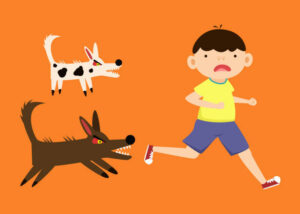
Why Do Dogs Bite?
One of the most frequent statements I hear from owners of biting dogs is “My dog bites for no reason!”
Hate to break it to ya, but I guarantee your dog had a reason. You just don’t recognize the cause of it. The urban myth that dogs just turn on people is so steeped in our collective conscience that we cannot imagine a time without it. The reason dogs bite continues to be interpreted as an irrational act, as opposed to in defense of a potential threat.
Since well before the pandemic, dog bites have been on the rise. Daily, our news reports horrify us with dog attacks where the outcomes for the humans are often fatal. There were 46 confirmed dog attack fatalities in 2020. There were 51 confirmed fatalities in 2021. The statistics compiled by the CDC in the US is 4.5 to 4.7 million reported dog bites per year.
Dogs aren’t moral creatures. Their days are not filled with calculating their actions or understanding how those acts will impact the lives around them, nor do they blindly act without reason. They respond to the information their environment has supplied them with, and make decisions based on their perceived safety.
What Makes An Aggressive Dog?
What most folks consider to be aggressive behavior, I consider to be defensive. As I have written many times throughout my career, aggression isn’t a disease, it’s a symptom. Aggression is the least understood behavior observed in dogs as a result.
Dogs have no difficulty communicating with their own species, and have demonstrated the same predictable behaviors for millions of years. It has also helped them adapt to life with humans. It is the human that is unpredictable, not the dog.
Wild canids arrived in their present form through the rigid and unforgiving process known as evolution. We began interfering obliquely at first, and then directly, probably much longer ago than the conservative 15 to 30-thousand-year estimates favored among popular archaeological timelines.
While the number one killer of wolves is other wolves, in the 21st century, the domestic dogs’ biggest enemy is homo sapiens.
Humans endured a lot of trial and error even after we discovered fire and how to forge metal, because we were prey before we were predators.
Our close companion, the dog, wild as he may have been, shadowed our movements across the globe for thousands of years, following in our footsteps as we followed him. We shared the same tastes in prey, we both hunted cooperatively, we collectively found safety in numbers, we each surrounded ourselves with family. Both species adhered to a fluid form of social hierarchy that is still observed today.
Humans quickly learned how animals behaved, and what precipitated those behaviors. Especially when it came to acts of violence. It was important to recognize the postures and expressions the animals engaged in when certain things occurred because that knowledge helped early humans stay alive.
We learned not to approach animals when they were eating, and if we did, it was with enough numbers and enough force to successfully drive them off without becoming a meal ourselves. Our predator companions learned not to venture off too far, because we were not only predictable, but occasionally, we were careless.
This mutual symbiosis struggled to remain essential past the industrial age.
The Evolution Of Anxiety In Dogs
Once the need for dogs diminished, our ability to understand them diminished with it. Our caution became carelessness and dogs became an afterthought to our survival. Our relationship with our oldest friend and helpmate deteriorated rapidly past the automation of our world, and only a few pockets of the dog as a functional utility to humans still exists. Instead they have been replaced by caricatures of themselves; ornaments to an unfitting lifestyle as a feature of social currency, virtue signaling or as our emotional foil.
Although our beliefs have changed, our canine companions have changed very little. They may come in a variety of sizes, colors and coat types, but behaviorally, they are the same animal they were thousands of years ago. They still adhere to the same behavioral constructs that have governed dog actions since they evolved from ancestor Mesocyon, over 20 million years ago.
We just lost the ability to understand their behavior, or what motivates it. And that’s why dogs bite.
The Nature Of Resource Guarding
It is an evolutionary advantage to be able to acquire and control resources. The collaborative hunting that wolves are famous for? Cooperation ends once that prey animal hits the ground. Barring caring for the very young, it’s every dog for itself.
Cooperative hunting may help to assure survival for the larger group as a whole, but the members of that group are not so assured. Weaker members are driven off and left to scavenge the remnants. The term “survival of the fittest” is simply a long and painful process of sharpening efficient, healthy, durable predators.
People call that resource guarding. Nature calls it survival.
What does that have to do with the biting dog? Just about everything.
It is the rare dog that attacks offensively without a reason. The first anti-social behavior observable in a litter of puppies as their ears and eyes open is resource guarding behavior. In fact, it is evident much sooner, as they scrabble around in the darkness, rooting for the warmest, most productive teats.
In the animal kingdom, fratricide occurs in many species, including among wild canids. They may not kill the sibling directly, but their intentions are to squeeze them out of access to the same resources. Survival of the fittest starts early in nature.
At the beginning of this post, I shared a few statistics about the ramifications of biting dogs. What they don’t reveal are breeds, ages of victims, or any other circumstances surrounding the event. Without making this a dispute over dog breeds and breed-specific legislation, be assured that the selection criterion used to create the breed of dog that could turn and drive a 2000-pound bull is the same criterion used to develop a breed capable of a 500-yard outrun to look for livestock it cannot see, and the dog that willingly dives into frigid water to retrieve a bird it will never consume.
All of these behaviors are related, and all of them have been teased out and exploited through the careful selection of traits that are native to all dogs; the predatory motor pattern sequence:
Orient
Eye
Stalk
Chase
Kill
Consume
African Wild Dogs are successful roughly 85% of the attempts to bring down game, where wolves are successful roughly 14% of the time. Both are cooperative hunters that hunt in family groups. It’s a numbers game. The solitary hunter has less chance of survival than a community of hunters. The more, the merrier!
Evolution endowed wild dogs with the temerity to keep trying. Natural selection is sort of a law of averages. In a certain ecosystem, there are going to be features that benefit few and test many. As resources begin to fade, evolution favors the adaptation of physiology that can overcome the new ‘odds’. Sensitive noses to locate game over longer distances, sharper teeth and more powerful jaws to tear flesh and crush bone, longer legs to run greater distances, heavier coats that are designed to insulate in the winter and shed in the summer.
Domestic dogs have been altered physiologically to accommodate the tiniest of toy breeds and the largest of giant breeds. They all have the same number of chromosomes, but they are markedly different in body type, size, coat color, texture, length, and head shape.
But they all share the same latent drives as their wild ancestors.
How Do You Fix A Biting Dog?
First, you recognize that you can’t fix what isn’t broken. You can certainly mitigate the risk by appropriate assessment, management, and remediation.
Dogs bite for two reasons and two reasons only; they are either acquiring resources or defending them.
If you are looking for help understanding how to handle your biting dog, I am here!


